Results
-
 £174.99
£174.99Two Symphonic Interludes - Harrie Janssen
Based on the poems by German poet Carl Hauptmann (late Romanticism) and the English poet William Wordsworth (early Romanticism). Carl Hauptmann was in poor health as a child, but highly intelligent. He studied philosophy, psychology and biology. In the latter he was admitted to the degree of doctor. His marriage provided financial independence, so that he could focus on his studies. Hauptmann wrote various novels, plays, poetry and scientific works. Night Twilight floats above the valley's night mists are hanging, there's a whispering brook. Now the covering veil is lifting quite: come and look! See the magicland before our gaze: tall as dreams the silver mountains stand, crossed by silent silver paths shining from a secret land. Noble, pure, the dreaming country sleeps. By the path the shadow black and hogh of a beach. a wisp of a white smoke creeps to the dark'ning sky. Where the valley is the darkest hued countless little lights shine silently. O my soul! Drink of solitude! Carl Hauptmann Wordsworth 'introduced' a new type of poetry, based on the speech of the common man. This was his answer to the poetry of the classicism which was bound by rigid rules. His definition of poetry was: the spontaneous overflow of powerful feelings from emotions recollected in tranquility. My heart leaps up when I behold a rainbow in the sky My heart leaps up when I behold A rainbow in the sky: So was it when my life began. So is it now I am a man. So be it when I shall grow old, Or let me die! The Child is father of the Man. And I could wish my days to be Bound each to each by natural piety. William Wordsworth In a truly poetic manner Harrie Janssen has transformed the contemplative thoughts of the poets into two compositions for Concert Band.
Estimated dispatch 7-14 working days
-
 £134.99
£134.99The Legend of Ratu Kidul - Filip Ceunen
The Legend of Ratu Kidul carries us into the world of Indonesian mythology, on the island of Java:Once upon a time, the Queen of the Southern Seas was a kind and beautiful princess. She was the daughter of Prabu Munding Wangi, the favourite ofthe entire court and the local people. Her royal father doted on his daughter. Her name was Dewi Kadita, but many called her Dewi Srengenge or the Angry Princess.Prabu Munding Wangi longed for an heir, but Dewi Kadita's mother couldn't fulfil thiswish. So he took a second wife, called Poetri Moentiara, who was very jealous of the lovely princess and her mother. She begged the king to banish both her rivals from court. However Prabu Munding Wangi didn't do as she asked. He loved his first wifeand her daughter. The second wife bore him a healthy heir, but the monarch remained firm. So Poetri Moentiara called upon the renowned witch, Djahil. She promised her a princely reward, if Dewi Kandita and her mother were banished. Djahil thought fora moment and incanted this rapal (spell): "May leprosy befall you both". Soon both mother and daughter began to suffer this dreadful disease. According to the law of the land, they were to be banished to the wild forest high on the mountain. With aheavy heart, King Munding Wangi saw the law carried out. So the two set off on their way to the forest, covered in terrible sores. A great sadness fell across the land, except for Poetri Moentiara, the second wife of the king, who had achieved heraim. The princess fell on hard times. In the forest lived a hermit, who took pity on the mother and daughter. The queen couldn't bear the shame and within a few days had died. Now Dewi Kandita was all alone in the world. There was still the hermit,however, who fortunately provided food and shelter in a cave temple. He bound her weeping sores but couldn't relieve her emotional pain. Dewi Kandita became increasingly bitter and eventually left the hermit. She travelled southward from village tovillage, further and further, until eventually she reached the shores of the Southern Sea. She climbed upon a high cliff and gazed out onto the sea that spread before her. She was tempted to dive into the deep green and blue. In the cool waters shewould be able to forget all her pain and suffering. Suddenly awaking from these thoughts, she jumped into the deep. The gods, who had looked on Dewi Kandita throughout her hardships, were filled with deep compassion. So they transformed her into apowerful spirit of the netherworld, Ratu Kidul, and to this day she resides in her grand palace under the sea.
Estimated dispatch 7-14 working days
-
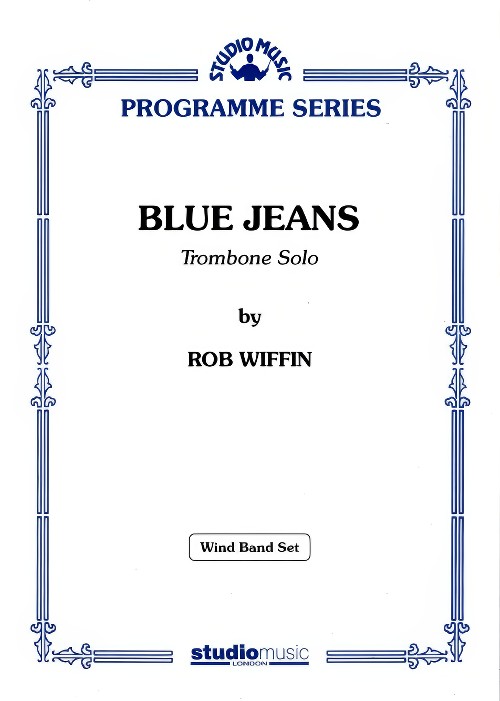 £59.95
£59.95Blue Jeans (Trombone Solo with Concert Band - Score and Parts) - Wiffin, Rob
In 2008 the trombonist, Chris Jeans, was invited to be a featured soloist at a British Trombone Society event. He contacted Stan Kitchen at Studio Music Company to see if he had any new material for trombone. Stan then got in touch with me, as I had already written a piece for another trombone player, Brett Baker. This piece, 'Shout' was programmed for the same event so we needed to find something new for Chris.The title 'Blue Jeans' came to my mind, thus linking a blues-style piece with the obvious reference to Chris's surname. I spoke to Chris and he liked the sound of it so then I had to go away and write a solo to match the title!I managed to get a version with piano accompaniment done in time for Chris to perform at the trombone event and have now had a chance to complete the band version. Chris is a great chap, a good friend and a wonderful trombone player so I hope people enjoy listening to this solo that bears his name.- Rob WiffinDuration: 3.30
Estimated dispatch 7-14 working days
-
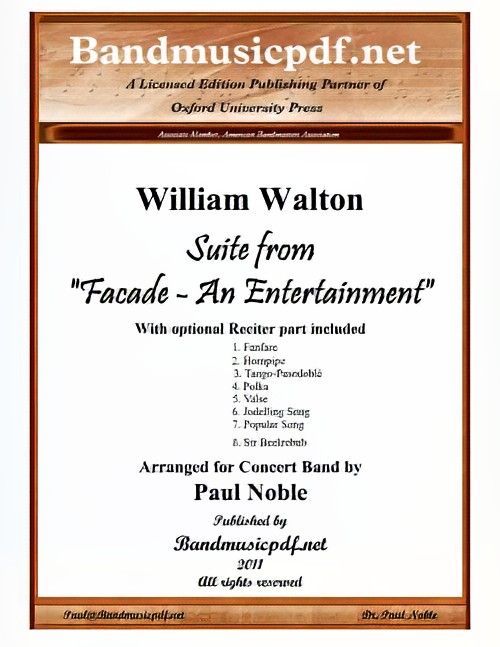 £375.00
£375.00Facade - An Entertainment, Suite from (Concert Band with Optional Narrator - Score and Parts) - Walton, William - Noble, Paul
This Suite from Facade - An Entertainment, composed by William Walton, with poems by Dame Edith Sitwell, presents for the first time a grouping of movements selected and arranged by Paul Noble for Concert Band and optional Reciter. The original composition was written between 1921 and 1928, containing forty-three numbers. They had their origin in a new style of poetry that Edith Sitwell evolved in the early 1920s, poems that her brother Osbert later described as 'experiments in obtaining through the medium of words the rhythm and dance measures such as waltzes, polkas, foxtrots... Some of the resulting poems were sad and serious... Others were mocking and gay... All possessed a quite extraordinary and haunting fascination.' Possibly influenced by the dance references in some of the numbers, Osbert declared that the poems might be further enhanced if spoken to a musical accompaniment. The obvious choice of composer was the young man who lived and worked in an attic room of the Sitwell brothers' house in Carlyle Square W[illiam] T[urner] Walton, as he then styled himself. The now historic first performance of the Facade Entertainment took place in an L-shaped first-floor drawing-room on January 24, 1922. Accompaniments to sixteen poems and two short musical numbers were performed by an ensemble of five players. The performers were obscured from the audience by a decorated front curtain, through which a megaphone protruded for Edith to declaim her poems. This was, as she put it, 'to deprive the work of any personal quality'. The first public performance of Facade was given at the Aeolian Hall on June 12, 1923. By now, fourteen poems had been set, others revised or rejected, and an alto saxophone added to the ensemble. The occasion gave rise to widespread publicity, both pro and contra, and the name of the twenty-one year old W. T. Walton was truly launched. In the ensuing years the Facade has gone through revisions and additions, with full orchestral arrangements of selected movements being made without the Reciter. Former Band Director Robert O'Brien arranged some movements for band, again without Reciter, which are now out of print. So this 'history making' addition is the first opportunity for Concert Bands to present some movements of Facade with poems as originally intended. The luxury of electronic amplification allows the full ensemble to perform without necessarily overshadowing the Reciter. And the arrangements are written with considerable doubling so that the ensemble may play in full, or reduced in size as may be desired for proper balance. And, though not encouraged, the arrangements are written so that the band can perform the music without the Reciter. Program notes are adapted in part from those written by David Lloyd-Jones and published by Oxford University Press in the Study Score of William Walton's Facade Entertainments.
Estimated dispatch 7-14 working days
-
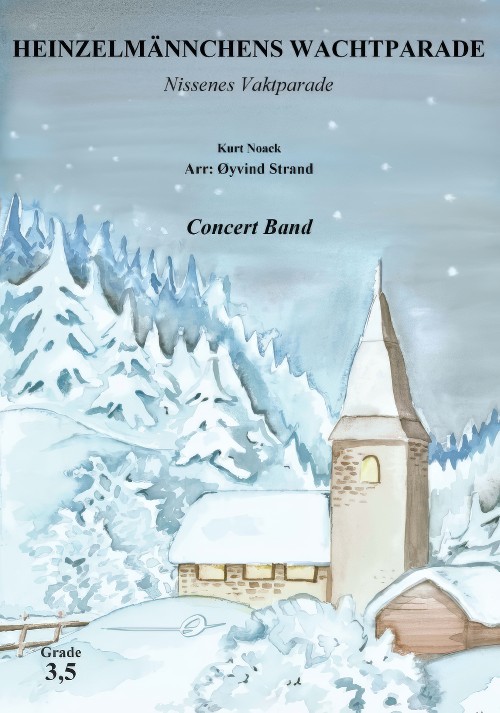 £94.00
£94.00Heinzelmannchens Wachtparade (Concert Band - Score and Parts) - Noack, Kurt - Strand, Oyvind
The story of the Heinzellmannchen (Gnomes) is connected to the German city of Cologne. The gnomes were small creatures living underground but appeared during the night, when the people were asleep, doing all the work that had to be done in the city, so that the citizens of Cologne could be lazy, relaxing the whole day. At last, there was a tailor's wife getting so curious about the gnomes that she scattered dried peas onto the floor so that the gnomes slipped and fell, making a lot of noise. The gnomes got infuriated and disappeared forever and the citizens of Cologne must thereafter do all the work themselves.Kurt Noack (1893-1945) was a German composer, arranger and orchestra leader, working mainly with light music and marches. The characteristic piece Heinzellmannchens Wachtparade (Gnome's parade) from 1912 is his most famous composition, originally written for piano.This arrangement is made a little parodic, filled with joyful interjections, trying to give these little gnomes a bit of character, with pictures from Disney's Santa's workshop in mind.Duration: 7.00
Estimated dispatch 7-14 working days
-
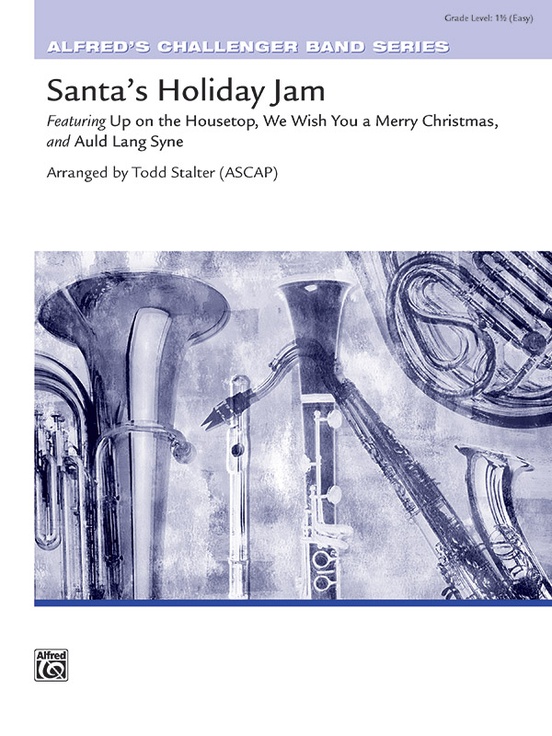 £52.95
£52.95Santa's Holiday Jam (Concert Band - Score and Parts) - Stalter, Todd
Are you ready to rock holiday style? Get your groove on with?Santa's Holiday Jam, a rock and roll medley of three timeless favorites for young players that is sure to put everyone in the spirit of the season. Arranged for young band by veteran composer/arranger Todd Stalter, this piece provides players with comfortable ranges and familiar rhythms in a comfortable key so they can focus on performing the music in an authentic rock style. Featuring "Up on the Housetop," "We Wish You a Merry Christmas," and "Auld Lang Syne." So, lay down that bass line, turn up the volume, and shake off the winter cold with this hot chart; so hot they'll want to play it in the summer! Duration: 1.45
Estimated dispatch 7-14 working days
-
£69.99
Kennesaw Mountain Blues - Stephen Bulla
Blues to the MAX! With lots of drive and down home blues harmonies, KENNESAW MOUNTAIN BLUES will latch on to your audience for keeps.Very accessible to Grade 2 1/2 bands, this is one of the most enjoyable pieces you'll find for any level of ability. If you have a kickin' drumset player, so much the better. Every section has gratifying parts to play, and the easy mixed-meter section sounds so natural but will keep 'em all thinking.The concert band doesn't often get the chance to play in styles like this, which is a shame, because it's so much fun. How about letting your band try a style that's about as far from John Phillip Sousa as you can get! Get down with some Blues! KENNESAW MOUNTAIN BLUES is a winner!
Estimated dispatch 7-14 working days
-
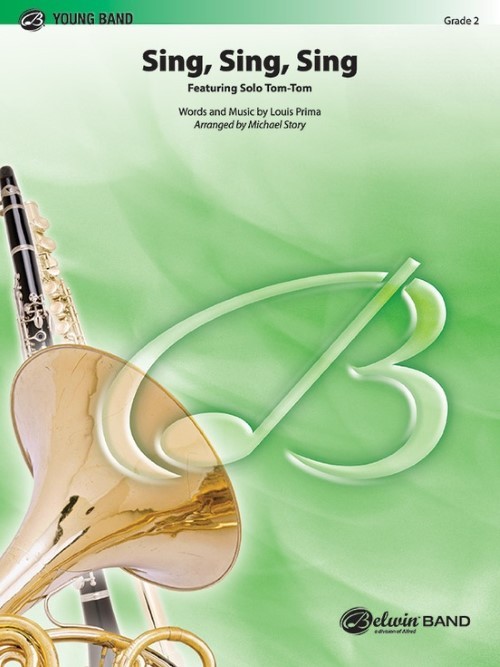 £58.50
£58.50Sing, Sing, Sing (Tom-Tom Feature with Concert Band - Score and Parts) - Prima, Louis - Story, Michael
When the music goes around, everybody goes to town. So goes the lyric to this classic tune that everyone knows and loves. Rare is it that a tune sounds so good to an audience and feels so good to the players. Simply said, this one works! Add this moment of instant identification to your next concert. Duration: 2.00
Estimated dispatch 7-14 working days
-
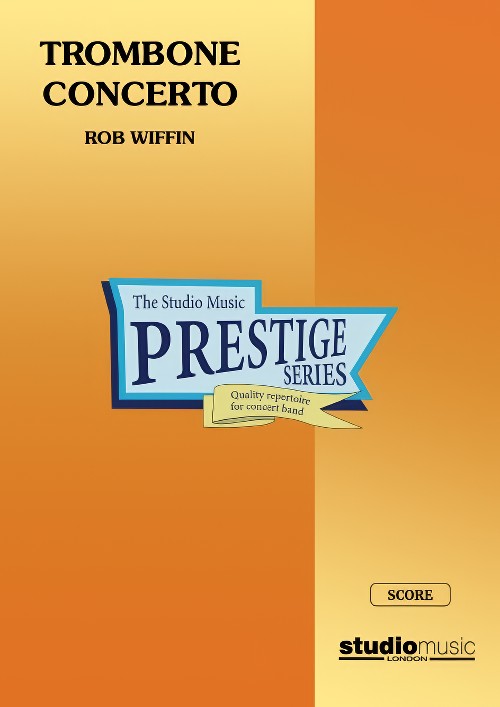 £32.95
£32.95Trombone Concerto (Trombone Solo with Concert Band - Score only) - Wiffin, Rob
The composer writes:My Trombone Concerto was commissioned by Brett Baker following an earlier piece I had written for him called Shout. The concerto was composed in Spain the summer of 2010. Once I started writing I realised this concerto was, inevitably, going to draw on my own experiences as a trombone player.The first movement was really a matter of getting the right thematic ideas and balancing the tutti and solo passages so, for formal structure, I studied the Gordon Jacob Trombone Concerto. There is a lyrical section preceding the first Allegro that owes much in spirit (but not the actual music) to The Eternal Quest, Ray Steadman-Allen's Salvation Army solo.The slow movement seemed determined to come out in the vein of a Richard Strauss song. I wanted to write ineluctably cantabile as we trombone players rarely get a chance to play the melody! There is a brief allusion to that wonderful moment when the trombone gets to sing above the orchestra in Sibelius' seventh symphony. Arthur Wilson (my teacher at college) died in the summer of 2010 so it seemed appropriate to dedicate this movement to him.The last movement is the lightest of the three in style and is slightly jazz-inflected, hopefully providing some fun for the soloist.While wanting to test the instrument, I did not set out with the intention of making the concerto difficult but there are undoubtedly challenges of technique, range and style to be met by the soloist.Recorded on Polyphonic CD QPRM161D Roman TrilogyDuration: 19:30
Estimated dispatch 7-14 working days
-
 £164.95
£164.95Trombone Concerto (Trombone Solo with Concert Band - Score and Parts) - Wiffin, Rob
The composer writes:My Trombone Concerto was commissioned by Brett Baker following an earlier piece I had written for him called Shout. The concerto was composed in Spain the summer of 2010. Once I started writing I realised this concerto was, inevitably, going to draw on my own experiences as a trombone player.The first movement was really a matter of getting the right thematic ideas and balancing the tutti and solo passages so, for formal structure, I studied the Gordon Jacob Trombone Concerto. There is a lyrical section preceding the first Allegro that owes much in spirit (but not the actual music) to The Eternal Quest, Ray Steadman-Allen's Salvation Army solo.The slow movement seemed determined to come out in the vein of a Richard Strauss song. I wanted to write ineluctably cantabile as we trombone players rarely get a chance to play the melody! There is a brief allusion to that wonderful moment when the trombone gets to sing above the orchestra in Sibelius' seventh symphony. Arthur Wilson (my teacher at college) died in the summer of 2010 so it seemed appropriate to dedicate this movement to him.The last movement is the lightest of the three in style and is slightly jazz-inflected, hopefully providing some fun for the soloist.While wanting to test the instrument, I did not set out with the intention of making the concerto difficult but there are undoubtedly challenges of technique, range and style to be met by the soloist.Recorded on Polyphonic CD QPRM161D Roman TrilogyDuration: 19:30
Estimated dispatch 7-14 working days
